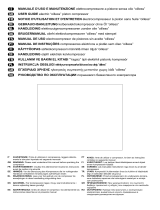
ENGLISH
8
the influence of alcohol, drugs or medication that makes you
drowsy.
15. CHECK FOR DAMAGED PARTS AND AIR LEAKS
Before further use of the compressor, carefully checked
the guard and other parts for damage to make sure that
it will operate properly and perform its intended function.
Check for alignment of moving parts, binding of moving
parts, breakage of parts, mounting, air leak, and any other
conditions that may affect its operation. A guard or other
part that is damaged should be properly repaired or replaced
by an authorized service center unless otherwise indicated
elsewhere in this Instruction Manual. Have defective pressure
switches replaced by authorized service center. Do not use
compressor if switch does not turn it on and off.
16. NEVER USE COMPRESSOR FOR APPLICATIONS
OTHER THAN THOSE SPECIFIED Never use compressor
for applications other than those specified in the Instruction
Manual. Never use compressed air for breathing or
respiration. Never stand on the compressor.
17. HANDLE COMPRESSOR CORRECTLY Operate the
compressor according to the instructions provided herein.
Never allow the compressor to be operated by children,
individuals unfamiliar with its operation or unauthorized
personnel.
18. KEEP ALL SCREWS, BOLTS AND COVERS TIGHTLY IN
PLACE Keep all screws, bolts, and plates tightly mounted.
Check their conditions periodically.
19. KEEP MOTOR AIR VENT CLEAN The motor air vent must
be kept clean so that air can freely flow at all times. Check for
dust build-up frequently.
20. OPERATE COMPRESSOR AT THE RATED VOLTAGE
Operate the compressor at voltages specified on their
nameplates. If using the compressor at a higher voltage
than the rated voltage, it will result in abnormally fast motor
revolution and may damage the unit and burn out the motor.
21. NEVER USE A COMPRESSOR WHICH IS DEFECTIVE OR
OPERATING ABNORMALLY If the compressor appears to
be operating unusually, making strange noises, or otherwise
appears defective, stop using it immediately and arrange for
repairs by an authorized service center.
22. DO NOT WIPE PLASTIC PARTS WITH SOLVENT Solvents
such as gasoline, thinner, benzine, carbon tetrachloride, and
alcohol may damage and crack plastic parts. Do not wipe
them with such solvents. Wipe plastic parts with a soft cloth
lightly dampened with soapy water and dry thoroughly.
23. USE ONLY GENUINE REPLACEMENT PARTS
Replacement parts not original may void your warranty and
can lead to malfunction and resulting injuries. Genuine parts
are available from your dealer.
24. DO NOT MODIFY THE COMPRESSOR Do not modify the
compressor. Always contact the authorized service center
any repairs. Unauthorized modification may not only impair
the compressor performance but may also result in accident
or injury to repair personnel who do not have the required
knowledge and technical expertise to perform the repair
operations correctly.
25. TURN OFF THE PRESSURE SWITCH WHEN THE
COMPRESSOR IS NOT USED When the compressor is not
used, turn the knob of the pressure switch OFF, disconnect it
from the power source and open the drain cock to discharge
the compressed air from the air tank.
26. NEVER TOUCH HOT SURFACE To reduce the risk of
burns, do not touch tubes, heads, cylinder and motors.
27. DO NOT DIRECT AIR STREAM AT BODY Risk of injury,
do not direct air stream at persons or animals.
28. DRAIN TANK Drain tank daily or after 4 hours of use.
Open drain fitting and tilt compressor to empty accumulated
water.
29. DO NOT STOP COMPRESSOR BY PULLING OUT THE
PLUG Use the “AUTO/OFF” knob of pressure switch.
30. USE ONLY RECOMMENDED AIR HANDLING PARTS
ACCEPTABLE FOR PRESSURE NOT LESS THAN 8.6 BAR
(125 PSI) Risk of bursting. Use only recommended air
handling parts acceptable for pressures not less than 8.6 bar
(125 psi).
31. WEAR PROPER HEARING AND HEAD PROTECTION
Suitable protective clothing must be worn when operating the
compressor and connected tool or accessory. Consult the tool
/ accessory manual and adhere to any safety requirements.
32. MAKE ALLOWANCE FOR ENVIRONMENTAL
CONDITIONS
Never leave the compressor in the rain. Never use the
compressor in damp or wet conditions. Provide good lighting.
Never use the compressor near combustible liquids or gases.
REPLACEMENT PARTS
When servicing use only identical replacement parts. Repairs
should be conducted only by authorized service center.
EXTENSION CORD
Use only three-extension cords that have three-prong
grounding type plugs and three-pole receptacles that accept
the compressor’s plug. Replace or repair damaged cord.
Make sure your extension cord is in good condition. When
using an extension cord, be sure to use one heavy enough to
carry the current your product will draw. An undersized cord
will cause a drop in line voltage resulting in loss of power and
overheating. Table shows the correct size to use depending
on cord length and name plate ampere rating. If in doubt,
use the next heavier gage. The smaller the gage number, the
heavier the cord.
When operating a power tool outdoors, use an extension cord
suitable for outdoor use. Use of a cord suitable for outdoor
use reduces the risk of electric shock.













